[Source: Darren Kitson]
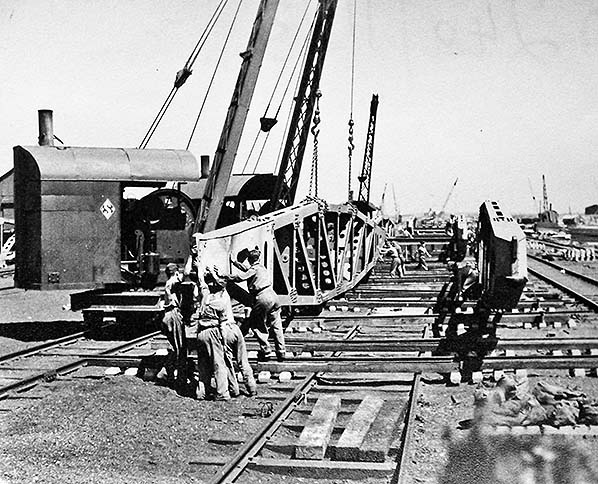
Whales being assembled at Marchwood and as can be seen were of the Pratt Truss type. What is happening here is the completed trusses are being lowered onto baulks to permit insertion of the roadway sections (not visible here) and final assembly. Whether Whale components were constructed at Marchwood or brought in from elsewhere for final assembly is unclear but photographic suggests the latter. Beetles, however, are known to have been built from scratch at Marchwood. A large number of rail-mounted steam cranes were used at Marchwood. The two nearest the camera are products of Thomas Smith & Sons, a firm perhaps better known for their 'Smiths Rodley' brandname with Rodley, Leeds, being the location of their works. These two cranes are probably of 7½ ton capacity. The firm had links with Joseph Booth & Sons, also of Rodley, and the two firms produced some near-identical products. One of Booth's 7½ ton efforts is now preserved as a static exhibit, or eyesore depending upon one's point of view, at Gloucester Docks.
Photo from the National Archives
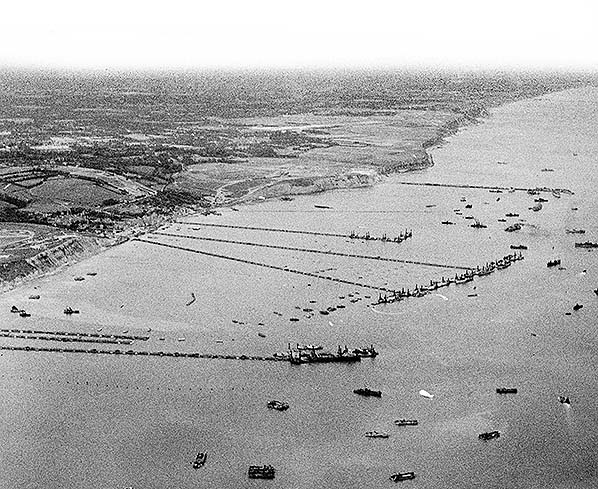
Mulberry B off the coast of Arromanches, Normandy, in September 1944. This view gives some idea of the large number of components required and in particular the Whales and Beetles forming the floating roadways. The structures at the pierheads are Spuds. These were to a clever but necessary design; they had legs which stood on the seabed but decks which varied in height according to the tide. Spuds were officially the name of the four 60ft long legs and the deck was in effect a 200ft by 60ft barge. A large number of Whales and Beetles were constructed at Marchwood. Note the barrage balloons, several of which can be discerned.
War Office Official © Imperial War Museum BU1024. Reproduced under Non Commercial Licence
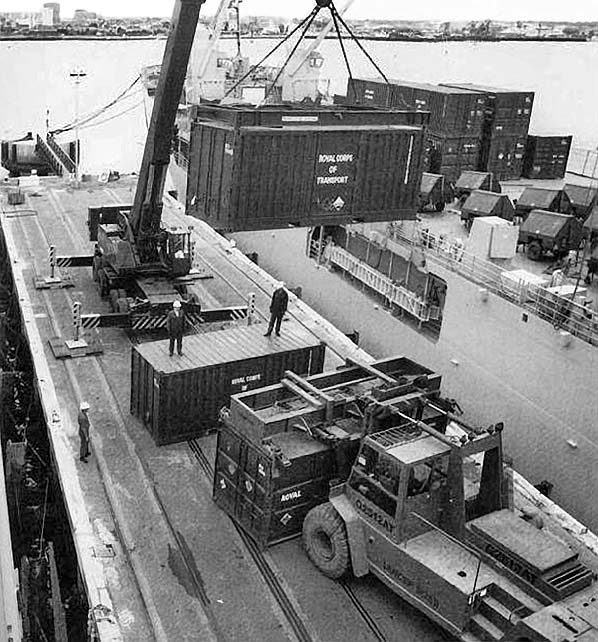
Royal Corps of Transport 20ft containers being loaded aboard an unidentified vessel from Mulberry Jetty. The date is unknown but will be between 1965, when the RCoT was formed, and the mid 1980s when Falklands Jetty was constructed. Regulations concerning containers, and in particular stacking, were changed in 1968 following which all containers became required to carry a CSC plate (Container Safe Convention). Assuming this also applied to military containers we can cautiously pin down the date of this photograph to the 1965 - 8 period as no CSC plates can be seen. The vehicle at the bottom of the picture is a Lancer Boss container handler. This type of vehicle is still in use today; military versions commonly being designated RTCH (Rough Terrain Container Handler) and capable of operating in water to a limited depth. Today, Health & Safety would have a field day over the two men standing on a container while another is more or less swung over their heads. Perhaps the hard hats filled
them with confidence

A busy scene at Marchwood Military Port's Mulberry Jetty. This photograph was one of several found many years ago in, of all places, a dustbin and consequently no information whatsoever came with it. Nevertheless, a picture tells a thousand words so all is not lost. In No.1 berth, left, bow doors open, is the 'Black Pig'; Royal Fleet Auxiliary (RFA) Landing Ship, Tank, 'Empire Gull', pennant number L3513. This vessel, built in Canada at the end of WWII, became a member of the RFA fleet in February 1970. Her history is known and her first appearance at Marchwood was on 6 September 1975 and her last on 4 October 1978 when she sent to Portsmouth to be laid-up prior to scrapping at Santander, Spain, in 1980 with scrapping completed on 7 May that year. She was withdrawn from service, at Marchwood, on 3 September 1978 thus we can date this photograph to the three year period between September 1975 and September 1978. However and although there is no overwhelming evidence, one gets the feeling the photograph depicts some sort of trial or demonstration. If so, the date is likely to be autumn 1975. The column of figures on L3513's starboard bow are Draft Markings, 'Draft' being the measurement between surface and bottom of keel. Draft Markings differ to a Plimsoll Line which, although serving a basically similar purpose, takes into account a number of factors such as water density, time of year, ship dimensions and so on. L3513 appears in another photograph in the Marchwood Military Railway Feature where there is more information on this vessel. Ahead of L3513 a Mexeflote or Buffer Pontoon can be seen, the writer is unsure which. This was prior to Marchwood receiving tide-adjusting linkspans. Visible are a number of Armoured Personnel Carriers and a Bedford MK lorry, known as a 'General Utility Truck'. The 'M' denoted 4 x 4 and the 'K' a multi-fuel engine. The MK was superceded by the turbo diesel MJ in 1981 and the MK/MJ was among the most rugged, reliable and versatile such vehicles ever produced - providing they were understood and well maintained, especially in the case of the MJ. The type lasted with the British military until as late as 2014. In No.2 berth, right, is Landing Ship Logistics 'Round Table' class vessel Sir Bedivere, pennant number L3004. Marchwood was her home port and as described elsewhere in this Feature was destined to be the vessel which undertook the sad task of returning home the bodies of 64 dead from the Falkland Islands in 1982. She returned the dead to Marchwood where they were taken to the cargo shed prior to being handed over to their families.
Photo from Andy Crespin
It is a common misconception that following the end of a war military personnel merely brush off the dust and return home. With the exception of conscripts, which insofar as modern history is concerned relate to the First and Second World Wars, the work of the military is far from over. As well as conscripts returning home to be 'Demobbed' (Demobilised) some regular troops also return home as does thousands of tons of equipment. At the same time, as happened in Germany, Allied 'Army of Occupation' troops continued to be based away from home. Perhaps the best known example of this was what became known as the 'British Army on the Rhine' which from 1994 became 'British Forces Germany' and is still active as of 2016 with some 21,000 troops. This is not through any threat from Germany, those days have long gone, but due to NATO co-operation and in no small part the former and so-called 'Cold War' which, at least in theory, saw the beginning of its end with the opening up of the Berlin Wall from November 1989. It was for the same reasons that until very recently the United States had a large number of military bases in the United Kingdom. The United Kingdom still has many overseas military bases mainly, but not exclusively, located in what are now known as 'British Overseas Territories'. At the time of writing there were still sixteen such locations with a British military presence. All this requires the transport of personnel, equipment and supplies, in both directions, as well as around the United Kingdom and this, together with training, is the main purpose of Marchwood. It is the United Kingdom's only military port as opposed to military dockyard.
It should not be forgotten that since WWII British forces have been involved in a number of other conflicts, most recently at the time of writing Afghanistan. Perhaps the most significant in respect of Marchwood was the already mentioned Falklands Conflict of 1982 which subsequently saw the building of Falklands Jetty. This, notwithstanding cutbacks to the military over many decades, and to a degree containerisation, has ensured the port continues to function today.
The port, or more correctly McMullen Barracks, is base to 17 Port and Maritime Regiment RLC; the RLC (Royal Logistic Corps) being headquartered at Deepcut, Surrey, while the port itself is to a large degree used by the Royal Fleet Auxiliary (RFA) and is base to some of the RFA's vessels.
To non-military people the RFA might appear a rather odd organisation. It is manned essentially by civilian personnel; its officers carry rank and insignia of the Merchant Navy while the bulk of the remaining personnel have, or have had, some sort of connection to the MoD but have not necessarily served in any of the main armed forces branches. However, Royal Navy personnel are present in addition and these deal with tasks civilian personnel cannot do such as handling weapons, operating helicopters and so on. When involved in conflict the RFA comes under Royal Navy discipline. The RFA not only undertakes logistics, its primary purpose, but also deals with humanitarian aid (something so often in the news) and, on at least one occasion, returning home the bodies of those killed in action

The RFA bases a number of vessels at Marchwood and here, on 16 August 2003, is Round Table class Landing Ship Logistics L3036 Sir Percivale. There were originally six of these vessels plus a further two to a later design; one as a replacement for another lost in the Falklands and one for the Royal Australian Navy but the latter vessel was built at Tomago, New South Wales. L3036 was built by Swan Hunter and launched on 4 October 1967. She was scrapped in 2010.That lost in the Falklands was the well known L3005 Sir Galahad. Built by Alexander Stephen & Sons and launched on 19 April 1966 she was bombed by Argentine aircraft on 24 May 1982 at San Carlos Water. The bomb, however, failed to explode and after removal Sir Galahad carried on her duties together with Sir Percivale. The following month, on 6 June, she was attacked at Port Pleasant while waiting to disembark soldiers. This time she was not so lucky and caught fire followed by a number of explosions resulting in the deaths of 48 soldiers and crew. Among the survivors was Guardsman Simon Weston (now OBE) who suffered 48% burns and has since become familiar for his media interviews. Captain Philip Roberts was also among the survivors and was the last crew member to leave the stricken vessel. Captain Roberts was subsequently awarded the DSO. Chiu Yiu-Nam, a crew member on Sir Galahad, was awarded the George Medal for rescuing ten men trapped in a fire in within the vessel. Sir Galahad was considered too badly damaged for repairs to be undertaken so on 21 June 1982 (the Falklands war had ended on 14 June) she was towed out to see and sunk by HMS Onyx, a Royal Navy Oberon class submarine. Her wreck is now a designated war grave. She was replaced by a new vessel bearing the same name and pennant number (L3005). Built by Swan Hunter and launched on 13 December 1986, she was sold to the Brazilian Navy in 2007 where she was joined the following year by L3004 Sir Bedivere. Both are believed to be still in service at the time of writing, the only members of the Round Table class to be so. Sir Bedivere, built by Hawthorn Leslie and launched on 20 July 1966, was a Marchwood based vessel and that which had the grim task of bringing home the remains of 64 dead (some sources state 80) in accordance with the wishes of their families. The dead were taken to the cargo shed at Marchwood from where they were returned to their families. This was the saddest event at Marchwood since WWII. May they rest in peace and their loved ones be proud.
Photo © Ian Boyle
The Future
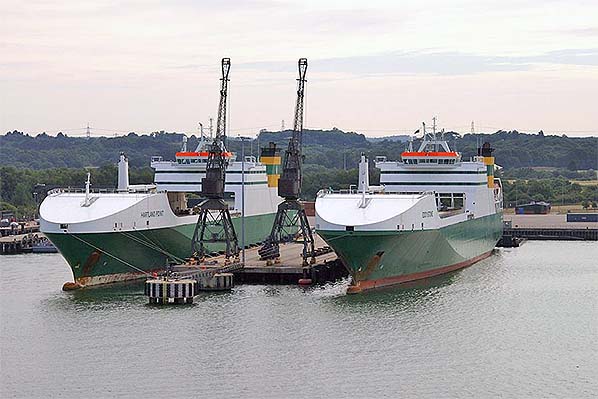
The RFA's Round Table class vessels plus RFA Sea Centurion and Sea Crusader were replaced by the Point class. Seen here at Marchwood in August 2006 are MV Hartland Point, left, and MV Eddystone, right. The Point class comprises six Ro-Ro Sealift vessels ('Sealift' means military cargo vessel) built 2002-3 under a Private Finance Initiative. Owned by Foreland Shipping, a company set up for the sole purpose of procuring, owning and operating the vessels, the latter hence the non military livery, they were originally on a 22 year contract to the MoD but only four vessels remain on contract as of 2016. Construction was split between Flensburger Schiffbau-Gesellschaft, Flensburg, Germany and Harland & Wolff, Belfast. The other vessels of the class are MV's Hurst Point; Anvil Point; Longstone; Beachy Head. Of those, Longstone and Beachy Head are the pair no longer on contract to the MoD. MV Anvil Point has the dubious honour of being the final ship to be built by Harland & Wolff, at least to date. Hartland Point and Eddystone were also Harland & Wolff vessels but, it is worth mentioning, there is some confusion over this as Eddystone, at least, was built under contract from Flensburger Schiffbau-Gesellschaft and thus can appear under both builders names according to source. The two 23,000 GRT vessels at Marchwood are berthed at Falklands Jetty, with Gunwharf Jetty partially visible at far left. The trees in the background make for a deceptively rural scene as most of the military activity is out of view to the right.
Photo © Ian Boyle
Over many years governments of either side of The House but usually instigated by the Conservatives have embarked upon crusades to sell off public assets or operate them via contracts or franchises via the private sector - an example being described with the photograph above. As we heard with monotonous regularity during the 2010 - 2016 period from, mainly, the thankfully now defunct Gideon Osborne, such moves are ostensibly to "look after the taxpayer" and, in Gideon's case, to "eliminate the deficit". The latter supposed objective failed miserably while at the same time the National Debt soared. Regarding the taxpayer, given all that has been sold off, 'privatised' or destroyed altogether over the years one might wonder why we now pay any taxes at all. A recent victim, as of 2016, of government policy is Marchwood Military Port. In October 2010 it was reported that the port was to be sold to a private operator but the port's continued use by the military was, then, something of a grey area.
On 12 July 2012 Peter Luff, the then Parliamentary Under-Secretary of State for Defence, issued the following statement which is © Parliamentary Copyright and reproduced under Open Parliament Licence.
Marchwood Sea Mounting Centre
The 2010 strategic defence and security review identified a number of Ministry of Defence (MOD) assets that would be considered for disposal. I would like to update the House on progress we have made on our commitment to sell the Marchwood sea mounting centre in Hampshire.
Sea mounting activities are vital to meeting the UK’s military requirements and will remain so in future. Our personnel at Marchwood, including 17 Port and Maritime
12 July 2012 : Column 42WS
Regiment, deliver a key capability to our armed forces overseas and the centre provides a valuable training facility for them at home.
Options for the sale of Marchwood have therefore been assessed with the continued availability of these capabilities in mind, including consideration of alternative UK locations from which sea mounting activities could be undertaken.
Based on this work I can reaffirm the intention to sell Marchwood. However, our analysis has led us to conclude that the preferred option is to continue to meet the sea mounting requirement from the same site. This will ensure that the military outputs can still be met while allowing greater economic and commercial benefit to be realised from the site. In doing so we envisage a much closer relationship between the MOD and industry in delivering these capabilities from a privately owned sea mounting centre.
MOD will now focus on developing the commercial proposal by the end of this year. Any sale will be dependent on the prevailing market conditions at the time, and the transaction will need to demonstrate that the required, assured defence capability can be delivered in a way which represents value for money.
On 27 March 2014 during a Commons Debate the following, reproduced here under the same terms as previously, was heard
Marchwood Military Port
Dr Julian Lewis: To ask the Secretary of State for Defence whether the military port function of the Sea Mounting Centre at Marchwood will continue to be operated in that location after the awarding of a lease to a commercial organisation for the development of part of that site; and if he will make a statement. [193440]
Mr Dunne: The Ministry of Defence will continue to use Marchwood for sea-mounting after the planned award of the concession. The concession will be structured to ensure that military outputs can still be met from Marchwood, while enabling greater economic and commercial benefit to be realised from the site.
On 3 March 2015 the BBC reported that the MoD had selected Solent Gateway Ltd. as the preferred bidder to manage Marchwood Sea Mounting Centre. One of several objections came from Associated British Ports, owners of the Port of Southampton, who were interested in Marchwood for 'car parking', presumably for the transport by rail of import/export cars but the finer details were unclear. Solent Gateway Ltd. were ultimately chosen in October 2015 and were due to take over during October 2016, the contract due to run for 35 years. As the title suggests, Solent Gateway Ltd. was set up in 2014 specifically with Marchwood in mind (purposely created companies being quite normal procedure when tendering for government contracts) and is joint venture between the David MacBrayne Group Ltd. and GBA Holdings Ltd. The former is a long established company well known for operating ferries to the Scottish islands and, at one time, buses. The latter is involved with port and what it terms 'Automotive Logistics' - car transportation in other words. This, in the light of Associated British Ports interest in Marchwood, plus Solent Gateway Ltd. being in part owned by the Scottish government makes the situation somewhat ironic. At the time of Solent Gateway's takeover the entire Marchwood site had some 600 military personnel and some 120 civilian personnel. One proviso of the contract states 'development' of the port but precisely what form this development will take remains to be seen.
Legacy of the Second World War
The Second World War (WWII) was of course the origin of what is now Marchwood Sea Mounting Centre/McMullen Barracks. The First World War is no longer within living memory insofar as ex service personnel are concerned, following the death of Harry Patch, the last surviving combat soldier, on 25 July 2009 at the age of 111. Harry is buried at Monkton Combe - a location famous for 'The Titfield Thunderbolt' filming - and present at his funeral at Wells Cathedral were soldiers from Britain, Belgium, France and Germany. The First World War has left a legacy in the form of film, shipwrecks, surviving pieces of equipment, on-the-ground evidence and of course the various memorials, memorial sites and war graves. In due course WWII will pass into history in a similar manner so it is fitting that reminders of Marchwood's WWII activities can still be seen in the Marchwood area will continue to be so for many years.
As we have seen, Marchwood was one of just many locations around the country involved with the Mulberry harbours but has become one of the few locations were the legacy can still be seen on the proverbial doorstep. One (there were two) of the Whale bridge sections can, at the time of writing, still be seen at the Red Funnel terminal, Southampton, while Beetles can be seen south of Marchwood along the shore of Dibden Bay. To allow for losses due to whatever cause, a surprisingly large number of Mulberry components were constructed. The total number of Beetles of various types, for example, is believed to have been 470 and a similar number of Whales would have been constructed. The total of Phoenix caissons appears to be lost in the mists of time but probably reached three figures

A line-up of Beetles along the shore of Dibden Bay, just south of Marchwood, seen here on 23 September 2010. These Beetles were installed during the 1950s as coastal defences in connection with reclaiming of marshland. They were towed into position, scuttled and then ballasted with gravel. A survey undertaken during 2012 revealed a total of 78 Beetles exist at this location, of which 39 are largely visible, as in this view, while 39 others are now largely buried.
Photo by Wessex Archaeology and reproduced from Flickr under Creative Commons Licence
As far as is known, Beetles were constructed at only four locations; Marchwood; Southsea (both waterfront sites); London docks; Clobb Copse. The latter is an obscure inland location at Bucklers Hard, not far from Beaulieu, and which is thought to have been a dredged former oyster bed. Clobb Copse also constructed six Phoenix caissons and during March 1944 a concrete dry dock which was used at Portland throughout the war. Water access to and from Clobb Copse was via the Beaulieu River. Beetles aside, the majority of construction of Mulberry components, experimental and production, was undertaken at a large number of locations around Britain - including in Wales and Scotland.
Over in France a number of Whales were used postwar to repair damaged bridges and a number continue to exist to this day, still doing the job they were designed to do albeit under entirely different application.

A bridge using Mulberry Whale components located at Horbourg Wihr, north-eastern France. The bridge was photographed on 28 September 2009. The Whales seen here are of a intermediate type which allowed for movement, at Normandy, due to weight of load and other factors.
Photo by Zebulon alsace and reproduced from Wikimedia Commons under Creative Commons Licence
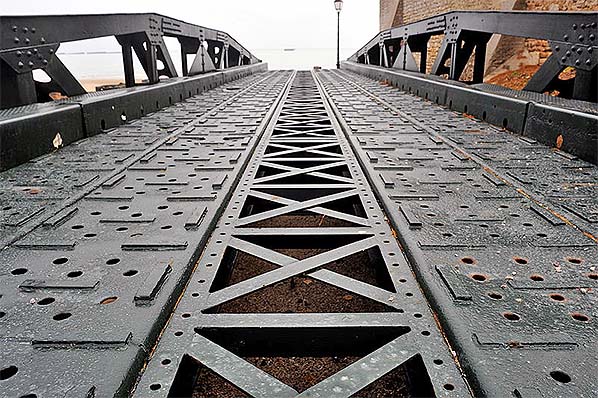
A rare close-up view of a Whale roadway, this one is to be found at Arromanches-les-Bains; Calvados, France and photographed on 6 June 2004. From 1948 to 2004 the Whale had been in use as temporary(!) bridge over the Meuse in Quincy-Landzécourt.
Photo by Хрюша and reproduced from Wikimedia Commons under Creative Commons Licence
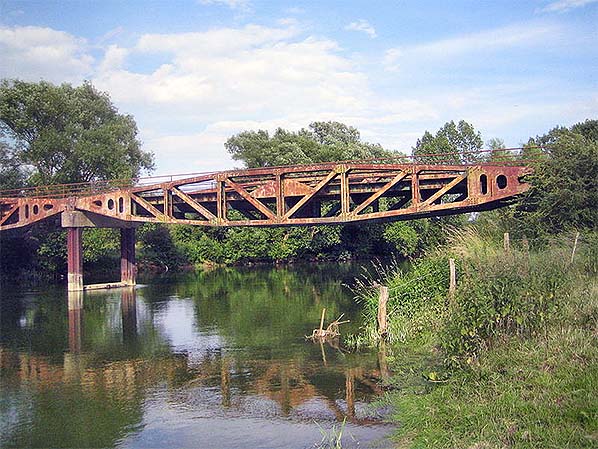
Bridge over the River Meuse using Whales of the more familiar type. This bridge is located in Vacherauville (Meuse) and was photographed on 18 June 2008. Constructed of steel plate and angle, despite these Whales apparently receiving little or no maintenance they appear to have stood the test of time well.
Photo by Foxandpotatoes and reproduced from Wikimedia Commons under Creative Commons Licence
In addition to the surviving Whales, which are just a few of many, seen in the above photographs, in the spring of 2016 another example was recovered from France, restored and is now on display at the Imperial War Museum, Duxford, Cambridge. This one had been part of Mulberry B at Arromanches. The Whale was rescued by Les Amis du Pont Bailey and brought to Duxford with the support of the family of the late Major Allan Beckett RE, the designer of the Whale. Major Beckett MBE died on 19 June 2005 aged 91.
A not inconsiderable number of the colossal Phoenix caissons can also still be seen. Most if not all of these have survived due to having some defect or other (they were prone to cracking) and thus never made it to Normandy, or had suffered storm damage either at sea or at Normandy. Others which had been sunk to avoid detection prior to refloating and towing to Normandy became stuck in silt and could not be refloated. These were simply abandoned where they lay and some remain thus to this day. The three following photographs just a few of several survivors.
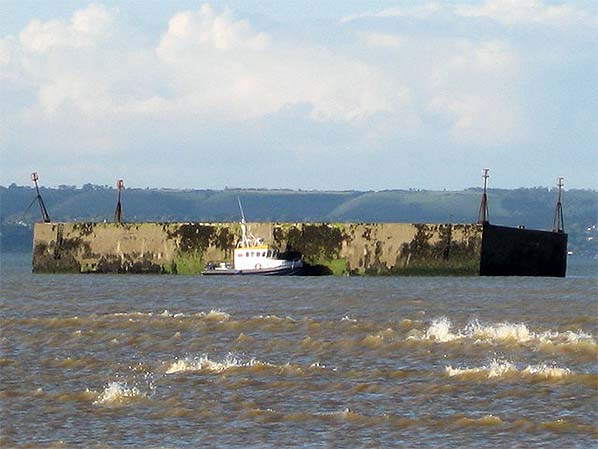
Photographed in May 2009, this Phoenix caisson is one of those which became stuck in the mud and could not be refloated. The location is Littlestone-on-Sea, which is as far the this caisson was to travel from its construction site on the Thames. The photograph was possible due to a low spring tide.
Photo by Simon Carey and reproduced from Geograph under Creative Commons Licence
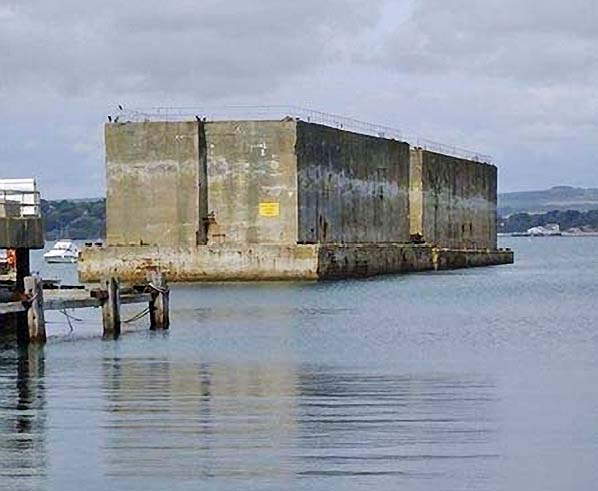
These two Phoenix caissons decided to embed themselves in Portland harbour where they were photographed on 23 August 2012 from Castletown slipway.
Photo by Stefan Czapski and reproduced from Geograph under Creative Commons Licence
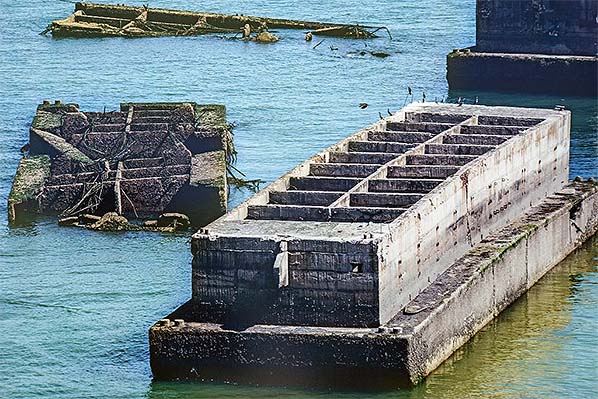
Derelict, in some cases very, Phoenix caissons at Arromanches-les-Bains, Normandy, on 23 June 2014. These caissons are thought to be part of Mulberry A, abandoned following storm damage on or around 19 June 1944.
Photo from Dennis Jarvis' Flickr photostream and reproduced under Creative Commons Licence
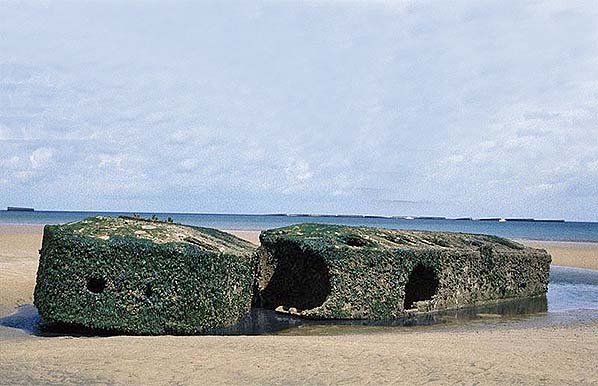
In addition to the Phoenix caissons at Arromanches there are a number of derelict Beetles. This sad looking pair were photographed on 1 January 1998 and judging from their appearance are submerged at high tide.
Photo by Tyler Bell from Wikimedia Commons and reproduced under Creative Commons Licence
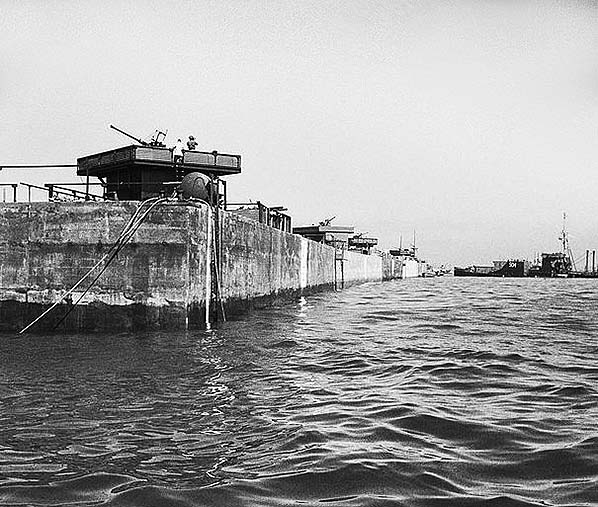
Finally, photographs of Phoenix caissons in service at Normandy are relatively uncommon so this view is included to show how they appeared with anti aircraft guns in position. This is Mulberry B at Arromanches on 12 June 1944.
© Imperial War Museum B5726. Reproduced under Non Commercial Licence.
Sources:
Online
Printed
- D-Day: The Battle for Normandy. Antony Beevor, Penguin 2014. ISBN -13: 978-0143118183
- The Normandy Mulberry Harbours. William Jordan, Pitkin 2005. ISBN - 13: 978-1841651576
- The Complete BR Diesel & Electric Locomotive Directory. Colin J. Marsden, OPC 1993. ISBN 0 - 86093 -508 - 6
Further Reading
The UK Government has produced a series of commemorative WWII 'booklets' in PDF format, including the D-Day. The series can be read or downloaded from https://www.gov.uk/government/publications/second-world-war-commemorative-booklets.
In addition there are a number of websites and online images available showing surviving evidence of Operations Neptune and Overlord, for example remains of the Mulberry Harbours and wreckage of tanks and other items of equipment which remain on the seabed to this day. Especially recommended is the website https://www.reseau-canope.fr and in particular this page. The website is available in both French and English.
For anybody in, or visiting, France there is the D-Day Museum, Arromanches which is well worth a visit along with that at Utah Beach and others. Brittany Ferries provide a list of the various museums and memorials in France and which can be seen here.
Acknowledgement
As will be understood, photographs taken within military premises are not easily obtainable but we have been fortunate in being able to use a number of photographs taken by Andy Crespin, a former driver on the Marchwood Military Railway, and our grateful thanks are extended to him.
Warning
Members of the public are advised that under no circumstances should they attempt to enter military premises, especially with cameras, and that attempts to take photographs from outside military premises may result in them being stopped and questioned by the authorities. A large number of former military railway items can be freely viewed and photographed at museums and heritage railways, while locations such as Long Marston, which are now of a semi-military status, still hold the occasional open day.
See also Marchwood Military Railway

















 Home Page
Home Page